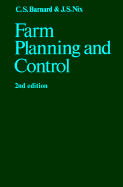Book contents
- Frontmatter
- Contents
- Notice to readers
- Preface to the first edition
- Preface to the second edition
- Selected metric conversion factors
- Part I The organisation of resources
- Part II The organisation of enterprises
- 6 An introduction to enterprise organisation
- 7 Livestock yield and fixed costs
- 8 Yield, variable costs and optimal feed conversion
- 9 The selection of feedstuffs
- 10 The influence of season on livestock production
- 11 The provision of replacements
- 12 Crops and cropping
- Part III The combination of enterprises
- Part IV The control of resources and enterprises
- Selected further reading
- Index
7 - Livestock yield and fixed costs
Published online by Cambridge University Press: 01 June 2011
- Frontmatter
- Contents
- Notice to readers
- Preface to the first edition
- Preface to the second edition
- Selected metric conversion factors
- Part I The organisation of resources
- Part II The organisation of enterprises
- 6 An introduction to enterprise organisation
- 7 Livestock yield and fixed costs
- 8 Yield, variable costs and optimal feed conversion
- 9 The selection of feedstuffs
- 10 The influence of season on livestock production
- 11 The provision of replacements
- 12 Crops and cropping
- Part III The combination of enterprises
- Part IV The control of resources and enterprises
- Selected further reading
- Index
Summary
Fixed costs in livestock production
'Fixed' and 'variable' costs have different connotations, according to the context in which they are used. In this chapter we shall be discussing them in relation to changes in livestock output. However, output may vary both because of alterations in the numbers of animals in a herd or flock and because of changes in their individual yields. For example, a milk producer, with an annual herd yield of 160,000 litres from 40 cows averaging 4000 litres, might obtain an extra 20,000 litres by raising herd numbers to 45 with no change in cow yields, or by keeping herd size constant and raising yields to 4500 litres. In the first case, with the extra cows and assuming resources are not initially under-utilised, many extra inputs will be required, so falling in the variable category. These will include more land to provide additional maintenance rations, extra purchased feed for production, extra AI fees and the like, and possibly additional accommodation and labour. In the second case, with raised output from the cows–given that they already have the capacity for the higher yields–the only major variable item will usually be the additional food needed to stimulate the extra milk; that is, the production ration.
Changes in size of unit are largely a matter of enterprise combination on the farm (the subject of the next part of the book) whereas, by contrast, variations in yield levels are mainly a question of organisation within the individual enterprise.
- Type
- Chapter
- Information
- Farm Planning and Control , pp. 165 - 180Publisher: Cambridge University PressPrint publication year: 1980



